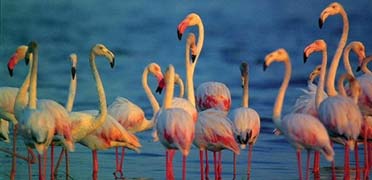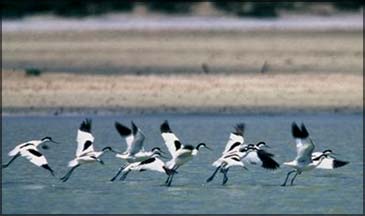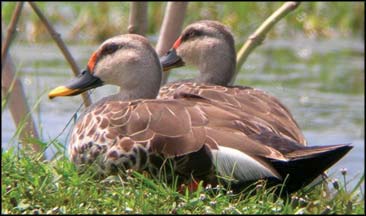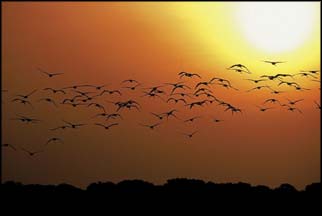From conflict to conservation
Vankalai Sanctuary first step towards conservation in
liberated north:
By Sajitha PREMATUNGE
 |
|
Sri Lanka Ratna Thilo
Hoffman |
 |
|
Greater Flamingos, from
north-west of India. Pic by Gehan Rajapakse |
Sri Lanka is the last landmark all the way to the Antarctic. It has
been a safe haven for migrant avifauna, seeking to escape the sub-zero
temperatures of the North, for millennia. For many such birds the Mannar
region, including Vankalai Triangle (Vankalai, Puliyantivu Island and
Tiruketiswaram) is their last stop at the end of the Central-South Asia
flyway as well as on their way back.
Resident species breed in-country, while migrants make their way into
another to breed during October to April. Some 200 migratory bird
species have been recorded from the Vankalai Triangle, now upgraded to
the category of Sanctuary. Lagoons, tidal mud flats, seasonal shallow
water-bodies, ponds with a variety of vegetation and a small reservoir
make the Vankalai Triangle an irresistible to migratory birds. Extensive
grass flats and scrubland provide ideal roosting grounds for thousands
of waterbirds, especially ducks and shorebirds. Various censuses
conducted except during 1992 and 2001, due to the security situation
have identified the Vankalai Sanctuary as invaluable for protection and
survival of large numbers of migratory waterbirds.
 |
|
Avocets at Vankalai
Sanct. Pic by Kithsiri Gunawardena |
It sustains well over the 20,000 waterbird mark which qualifies it as
a Ramsar site, in approximately 4,800 ha. In 2003 a census came up with
120,134 birds! Among the migrant species that make Vankalai Sanctuary
their home, the presence of three populations Greater Flamingo, Eurasian
Wigeon and Black-tailed Godwit separately qualifies it as a Ramsar site.
Eurasian Oystercatcher, Bar-tailed Godwit, Red Knot and Pied Avocet are
a few other rare migrants in Sri Lanka, observed in the area.
Although it was proposed several times before; the armed conflict has
prevented such interventions. But the conflict had acted as a blessing
in disguise. It limited the interaction between humans and local
wildlife such as regular shooting of ducks for about 20 years. As a
result migrant turned resident the Indian Spot-billed Duck have been
found breeding on site.
This is only the second such instant where a migrant bird established
itself in the country. Only about five Spot-billed Ducks had been
spotted in the half century before 2003.
"Birds come to the Vankalai Sanctuary from all over. All parts of
Asia, from the Black Sea in the west to Manchuria and Kamchatka in the
east, from India as the southern limit to Arctic Siberia as the
northern. They come from many parts of India.
 |
|
Spot-billed Duck at
Mannar. Pic by Kithsiri Gunawardena |
The Spot-billed Ducks may have crossed over from south India" said
Ceylon Bird Club (CBC) Committee Member Udaya Sirivardana.
Since the Ceylon Bird Club a non-governmental, non-profit
organization was founded in 1943, it has continuously been active in
collecting, recording and providing information on the birds of Sri
Lanka, their status and distribution.
In order to conserve bird diversity the club strives to find out
which bird forms are threatened, the club monitors their survival,
habitats, and conducts surveys. Many surveys have been conducted by CBC
in Vankalai Sanctuary and it was their persuasion and data that
facilitated the upgrade of area to the status of Sanctuary.
 |
|
Flamingos Pic byPalitha
Antony |
However elevating it to the status of Sanctuary was originally
proposed by Thilo Hoffman, then Chairman and the current Chairman
Emeritus of CBC and a leading figure in conservation. "He single
handedly worked to save Sinharaja and saved a large part of Vilpattu"
says Udaya Sirivardana.
It has been recommended for a sanctuary many times before, when it
was devoid of any settlements. Consequently the issue of depriving land
for human settlement never arose. The fact that the area is uninhabited
except for an Army camp and is under government and Army control has
facilitated in it being classified as a Sanctuary.
The Vankalai Sanctuary is the first PA (Protected Area) declared in
the North since the armed conflict began. The Department of Wildlife's
decision to extend the Sanctuary to Pallimunai is caused for much
rejoicing among environmentalists. |

